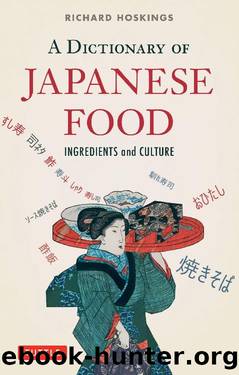A Dictionary of Japanese Food: Ingredients and Culture by Richard Hosking

Author:Richard Hosking [Hosking, Richard]
Language: eng
Format: epub, mobi
ISBN: 9784805313350
Amazon: 4805313358
Publisher: Tuttle Publishing
Published: 2015-02-24T00:00:00+00:00
sansai 山菜 mountain vegetable. There used to be a clear distinction between sansai and yasai (cultivated vegetables) but nowadays this is not so clear, since some sansai, such as warabi, are cultivated, and some yasai, such as mitsuba, seri, and fuki, also grow wild. Sansai convey a strong sense of spring and are a great favorite of vegetarians, often featuring in the menus of shōjin ryōri. For a list of the main sansai plants see also Appendix 9. The seven herbs of spring and autumn, though mostly picked from the wild, are not generally included in the category of sansai, perhaps because they are regarded as medicine rather than food. See also nanakusagayu.
sansai ryōri さんさいりょうり 山菜料理 cooking with wild herbs and vegetables. Many of these herbs and vegetables need preliminary preparation, such as blanching, to remove bitterness. After this, they are usually prepared as tempura, soup, o-hitashi, aemono, or nimono. See also Appendix 9.
sanshō さんしょう 山椒 Japanese pepper Zanthoxylum piperitum. The seedpods of the Japanese prickly ash are ground and used as pepper, above all in the seven-spice mixture shichimi tōgarashi. These pods are aromatic rather than hot and have a slightly numbing after-effect on the tongue, very similar to that of the closely related Szechwan pepper, Zanthoxylum bungeanum (or Zanthoxylum bungei or Zanthoxylum simulans). (Note: Fagara is no longer used as the genus name for any of the prickly ashes.) Sanshō is usually bought ground, since it keeps its aroma pretty well. It is mostly used with grilled eel and chicken to counteract the flavor and smell of fat. Sprigs of kinome (the young leaves of sanshō) provide a highly aromatic addition to many dishes, whether as an edible garnish or as herbal ingredient, chopped, brayed, or made into a paste. These little leaves are used to good effect in suimono, aemono, yakimono, and tsukemono. Their aroma, which is in the area of mint and basil with a touch of licorice, is brought out with gentle beating. The seeds of sanshō, which are very bitter, are not used, being removed from the pods and discarded. A pickle is made of the berries.
Download
A Dictionary of Japanese Food: Ingredients and Culture by Richard Hosking.mobi
This site does not store any files on its server. We only index and link to content provided by other sites. Please contact the content providers to delete copyright contents if any and email us, we'll remove relevant links or contents immediately.
A Dictionary of Sociology by Unknown(3045)
The Art of Dramatic Writing: Its Basis in the Creative Interpretation of Human Motives by Egri Lajos(3040)
The Dictionary of Body Language by Joe Navarro(2971)
0041152001443424520 .pdf by Unknown(2820)
How The Mind Works by Steven Pinker(2784)
Day by Elie Wiesel(2752)
Merriam-Webster's Collegiate Thesaurus, Second Edition by Merriam-Webster Inc(2732)
The Meaning of the Library by unknow(2537)
The Official Guide to the TOEFL Test by ETS(2301)
A History of Warfare by John Keegan(2216)
The Emotion Thesaurus: A Writer's Guide to Character Expression by Puglisi Becca & Ackerman Angela(2128)
Emotion Amplifiers by Angela Ackerman & Becca Puglisi(2016)
MASTER LISTS FOR WRITERS: Thesauruses, Plots, Character Traits, Names, and More by Bryn Donovan(1924)
Merriam-Webster's Pocket Dictionary by Merriam-Webster(1912)
The Cambridge Guide to English Usage by PAM PETERS(1890)
Star Wars The Rise of Skywalker The Visual Dictionary by Pablo Hidalgo(1866)
More Than Words (Sweet Lady Kisses) by Helen West(1840)
Lucky Jim by Kingsley Amis(1730)
American Accent Training by Ann Cook(1643)
